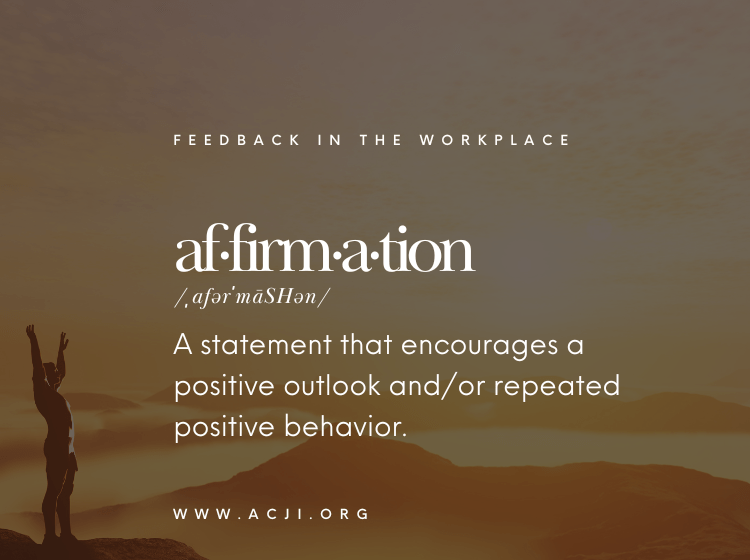The Power of Affirmations in the Workplace
July 16, 2024 – When we think of feedback, our minds drift to the negative. Performance evaluations highlight areas for improvement, red-lined edits on shared work spotlight our mistakes, and even the classic “coaching sandwich” emphasizes the criticism nestled between two slices of positive reinforcement.

An affirmation is defined as a statement that encourages a positive outlook and/or repeated positive behavior. You often hear affirmations in self-help and professional development circles, but there is no reason affirmations can’t show up more in the workplace, too.
Negativity Is Our Default
This focus on the negative isn’t just anecdotal—it’s rooted in our psychology. Our brains are wired to fixate more on negative experiences. The English language even boasts a more extensive vocabulary for negative concepts compared to positive ones. Despite knowing that positive incentives and strength-based approaches are powerful motivators, we still often treat these elements as afterthoughts in our interactions with clients, peers, employees, and even ourselves—because we are wired to do so!
<<Learn more about appreciative thinking in this ACJI blog post>>
The bottom line is that people don’t receive enough feedback about what they are doing well. In the absence of this information, they fill in their own ideas of how they’re performing and how they’re perceived by those around them.
In a recent ACJI training on Motivational Interviewing (MI), we asked learners to think deeply about an affirmation they would love to hear from someone in their life. What came next inspired us. But before we share what we heard, we want you to take a turn.

Start With Affirmations for Yourself
Pause and write down one or more meaningful affirmations you would love to hear from a boss, co-worker, friend, or family member. What did you come up with? Highlight your favorites and make a point to tell yourself these affirmations from time to time.
Affirmation Examples for the Workplace
As promised, here are several affirmation examples we received in that recent training. Do you notice a pattern?
- “Your determination is an inspiration and positive influence on those around you.”
- “You are passionate about your job and genuinely care for your staff.”
- “You are fiercely dedicated to changing outcomes for your participants.”
- “You are valued for your skills, aptitude, and hard work.”
- “You are a compassionate listener and diligent worker.”
- “You meet people where they are and love them beyond where they’re at.”
- “You are a passionate and ethical hard worker and ally.”
- “You have worked really hard to get to the position you are in at work.”
- “You put yourself in other people’s shoes and think about how they would feel.”
- “You genuinely care about others and show it through your actions every day.”
Connecting Feedback to Purpose
A Gallup survey found that seventy percent of employees define their sense of purpose largely through their work. Yet, when we give feedback, we often overlook connecting it to people’s deeper values.
Research around belonging highlights that the crisis of worker engagement is partly because people do not feel seen, heard, and valued as their authentic selves at work. We are neurobiologically wired to belong. When people can bring their whole selves to the workplace, they engage more deeply with their purpose.
Imagine if everyone on your team felt connected to their purpose through their work and valued for who they are. This is achievable by starting with belonging cues—subtle actions that build psychological safety.
- Have a conversation about your “why.” Get curious about others’ motivations and share your own.
- Intentionally notice and affirm others. Go beyond traditional feedback and recognize strengths and contributions.
- Talk about real things. Share more of your true self and get to know others on a deeper level.
- Reach out to those who may feel left out. Make an effort to connect with everyone.
- Listen more deeply. Give your full attention and show genuine interest.
- Prioritize relationships. Invest time and energy into building strong connections.
- Express more gratitude. Regularly acknowledge and appreciate others.
- Acknowledge your mistakes and be vulnerable. Show that it’s okay to be human.
- Discuss a shared vision of the future. Ensure it includes everyone.
- Integrate belonging cues into your processes. Include them in onboarding, training, and team meetings.
To Sum Up
By fostering an environment where people feel seen, heard, and valued, you can create a workplace where everyone thrives. Let’s start a movement toward more meaningful feedback, affirmations, and a true sense of belonging.




